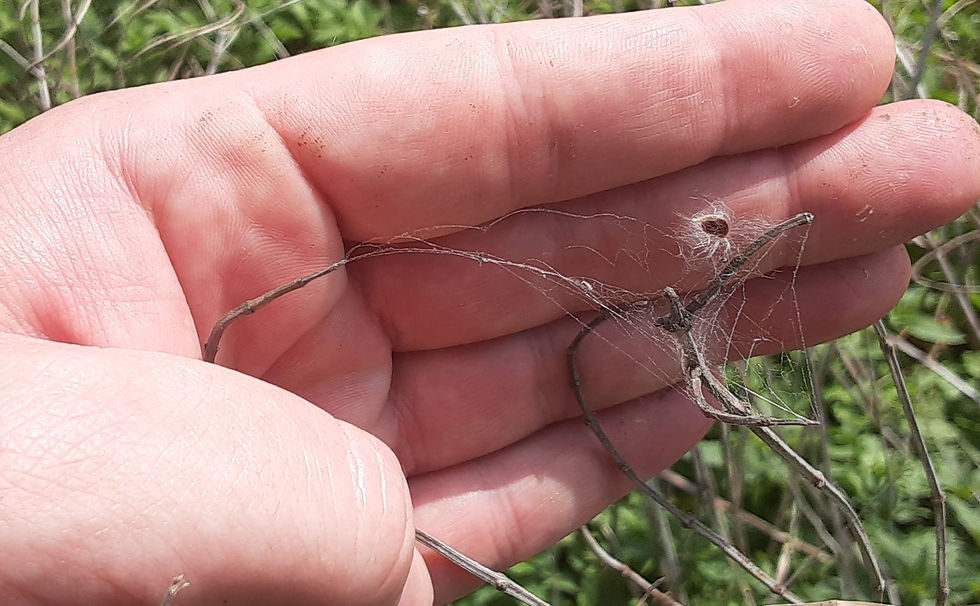A Garden Workday at Bird's Fort Trail Park... by Texas Master Naturalist Caleb Hinojos
- FIG

- Apr 11, 2023
- 4 min read
Hello everyone! This first weekend of April was a really great time to be outside. Not only was the weather great for us but the wildlife seemed to agree as well. Upon getting out of my car the first thing that caught my senses were the birds. Not too far from the parking lot were
a pair of Canadian Geese. After that I heard a flock of Cedar Waxwings. This was exciting
because this told me that migration was underway. I finally ended up seeing the group after
about 35 minutes. It was 50 strong! Other notable characters included our state bird the Northern Mockingbird, a couple of White-throated Sparrows, as well as a few Black Vultures circling high above. The next thing I noticed were all of the blooming flowers outside of the garden. The White Clover shown bright against the green backdrop while the Smallflower Desert Chicory glowed a yellow that mimicked the sunshine that hit it. The purple blooms were less numerous but stood out like the noble color they sport. This honor goes to the Dwarf Sorrel Broomrape. All these colors were signs telling me that it was going to be a great day in the garden.
After saying hello to the fellow volunteers, I began to scan the garden. At first glance I was very happy to see all the evidence that there were a ton of creatures moving around
even though I didn’t see any. The most notable to me were the shelters and there were plenty. On the oak tree in the garden, I found quite a few galls like that as seen in figure 1. These form due to an irritation that has occurred to the leaf such as predation or an insect laying its egg, but are also sometimes formed due to bacterial or fungal infections. Out of the handful of lower branches that I looked at I estimate that anywhere between 50-60 were within my reach. Luckily this is nothing to fret over. This is actually quite common and should have no noticeable effect on the tree other than aesthetics.

Figure 1: Succulent Oak Gall Wasp. Notice the hole where the wasp has bored out of the gall.
Other homes that I saw included those of spiders. What makes these so special to me is seeing how they capitalize on small niches. Take for instance figures 2 and 3. These webs are in places that see quite a bit of insect activity, so it makes sense to place a web for the unsuspecting prey.

Figure 2: A small spiderweb has captured a seed. Within the red
circle the is the spider well camouflaged.

Figure 3: A spider has placed a web over the face of a leaf
while having a shelter near the stem to wait for prey.
Apart from the spiders and gall wasps, the ants also made themselves a nice little home in
what I believe is the stem of a sunflower (figure 4).Although you cannot see it in the picture there was actually a line of ants leading up the side of the stem and into the core of it. The most exciting find when it comes to domiciles for me was that of a paper wasp (figure 5). Although many people may have a fear or dislike of wasps this should not be the case. In fact, they can be a good source of pest control in the garden for unwanted caterpillars of
many species. Although this makes some people dislike them for feeding pollinators to their young, the adults, in fact, inadvertently help to pollinate since their primary energy source is nectar. Don’t underestimate their overall value. I was unable to get a good shot of any of them due to their constant movement, but from what I could tell there were at least two species in the garden that day.

Figure 4: A small ant walks along the top of the stem before heading down into the colony.

Figure 5: This is a nest belonging to a paper wasp in the genus Polistes.
*Note three eggs occupying the topmost cells in the nest.
Apart from their homes the creatures are what really excited me.
They were out in abundance, but unfortunately some of the coolest
eluded my lens. However, there were still quite a few species and showed
just how diverse the garden is. Just outside of the garden was a Grey Hairstreak butterfly (figure 6). Crawling along the plants in front of the Cannas was a jumping spider (figure 7). These are very interesting to watch because their limbs operate through hydraulics. Hidden among the white clover was a very pretty looking fly (figure 8). I was fortunate that it decided to rest for so long. Luckily, we have quite a bit of ladybugs in the garden (figure 9). Not only do their larvae look like aliens, but they are a great predator of aphids. Finally at figure 10 we have a Lateral-lined Sharpshooter. Evidence of these insects won’t be found due to biting because their mouth parts are arranged like a straw to suck nutrients from the plants. Although this was nowhere near all the species found, it gives a good idea of the diversity which has already arrived. I can’t wait to see what the next visit brings.

Figure 6: Grey Hairstreak

Figure 7: Colonus puerperus

Figure 8: Condylostylus

Figure 9: Asian Lady Beetle

Figure 10: Lateral-lined Sharpshooter





Comments